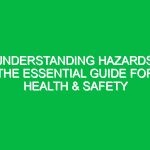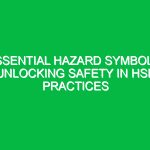Introduction
Hello, team! Today, we gather for this Toolbox Talk to discuss a critical aspect of our work Environment: Knowing What to do in an Emergency. Emergencies can happen at any time, and being prepared can make the difference between a minor incident and a serious disaster. This talk is designed to equip you with the knowledge and confidence to react effectively in emergency situations. Let’s dive into the essential actions we need to take when faced with an emergency and understand how these actions contribute to our overall Safety and well-being on the job.
The Importance of Knowing What to do in an Emergency
Understanding how to respond in an emergency is vital for several reasons. First, it can save lives. Quick and appropriate action can prevent injuries or even fatalities. Second, knowing the correct Procedures reduces panic and confusion, allowing everyone to work together to resolve the situation. Lastly, being prepared enhances our overall Safety culture, encouraging proactive behavior among all employees.
Types of Emergencies
Before we discuss specific actions, let’s review the common types of emergencies we might encounter in our work environment:
- Fire Emergencies: Fires can start from various sources, including equipment malfunctions or improper storage of flammable materials.
- Medical Emergencies: These may include injuries, falls, or sudden health issues among coworkers.
- Natural Disasters: Events such as earthquakes, floods, or severe weather conditions can disrupt operations and pose significant risks.
- Hazardous Material Spills: Chemical spills can occur during transportation or storage and require immediate action to contain and clean up.
- Violence or Threats: Situations involving aggressive behavior or threats can escalate quickly and require immediate intervention.
Understanding these emergencies helps us prepare better and ensures that we are ready to act when necessary.
Emergency Preparedness: Best Practices
To effectively respond to emergencies, we must follow Best Practices. Here are some key areas to focus on:
1. Know the Emergency Procedures
Every workplace should have clear emergency procedures in place. Familiarize yourself with these procedures, including:
- Evacuation routes and assembly points
- Emergency contact numbers
- Location of first aid kits and fire extinguishers
- Specific protocols for different types of emergencies
2. Attend Training Sessions
Regular training sessions on emergency procedures are crucial. These sessions not only inform you about the protocols but also provide practical experience through drills. Participate actively and ask questions to clarify any uncertainties.
3. Conduct Regular Safety Drills
Safety drills are an excellent way to practice emergency procedures in a controlled environment. They help reinforce the knowledge and skills needed to respond effectively. Ensure you participate in all scheduled drills and take them seriously, as they are designed to prepare you for real-life scenarios.
4. Create an Emergency Response Team
Forming an emergency response team within your department can enhance preparedness. This team can be responsible for ensuring that everyone knows their roles during an emergency, facilitating communication, and providing training to new employees.
5. Keep Communication Open
Effective communication is key during an emergency. Ensure that you know how to report an emergency and who to contact. Use clear and concise language when communicating the nature of the emergency to avoid misunderstandings.
Knowing What to do in an Emergency: Specific Actions
Now, let’s explore specific actions you should take during various emergency scenarios:
1. Fire Emergencies
In the event of a fire, remember the acronym RACE:
- R – Rescue: Assist anyone who may be in immediate danger.
- A – Alarm: Activate the fire alarm and call emergency services.
- C – Contain: Close doors behind you to contain the fire.
- E – Evacuate: Follow the designated evacuation routes and gather at the assembly point.
2. Medical Emergencies
If you witness a medical emergency:
- Assess the situation: Ensure it’s safe to approach.
- Call for help: Notify a designated first aid responder or call emergency services.
- Provide assistance if trained: If you are first aid certified, follow your training to help the injured person until professional help arrives.
3. Natural Disasters
In the case of natural disasters, follow these steps:
- Stay informed: Keep updated with weather alerts and advisories.
- Follow emergency plans: Adhere to the established procedures for your specific location.
- Protect yourself: Take cover, move to safe areas, or evacuate as necessary.
4. Hazardous Material Spills
If a hazardous material spill occurs:
- Evacuate the area immediately.
- Notify your supervisor and the emergency response team.
- Do not attempt to clean up unless you are trained and have the proper equipment.
5. Violence or Threats
In the case of workplace violence or threats:
- Stay calm and assess the situation.
- Evacuate if safe to do so.
- Contact security or emergency services immediately.
- Do not confront the aggressor unless absolutely necessary for self-defense.
Real-Life Examples and Scenarios
To better illustrate the importance of Knowing What to do in an Emergency, let’s look at a couple of real-life examples:
Example 1: Fire Emergency
In a manufacturing facility, an employee noticed smoke rising from a machine. Instead of attempting to extinguish the flames alone, the employee activated the alarm and alerted others. Everyone followed the Evacuation Procedures, which ensured that all employees were accounted for at the assembly point. The quick response of the employee potentially saved lives and minimized property damage.
Example 2: Medical Emergency
During a routine Operation, an employee suffered a severe cut. A coworker, trained in first aid, quickly assessed the injury, applied pressure to stop the bleeding, and called for assistance. Thanks to their training and prompt action, the injured employee received medical attention quickly, preventing further complications.
Regulations and Standards
Understanding the Regulations and standards regarding emergency preparedness is crucial. Organizations such as OSHA (Occupational Safety and Health Administration) provide guidelines that require employers to have emergency action plans in place. These plans must include:
- Emergency escape procedures
- Procedures for reporting emergencies
- Training and drills for employees
Compliance with these regulations not only ensures a safer workplace but also protects the organization from potential legal liabilities.
Conclusion
As we wrap up this Toolbox Talk, I want to emphasize that Knowing What to do in an Emergency is not just a guideline; it’s a necessity. Your preparedness and willingness to act can significantly impact not only your safety but the safety of your colleagues as well. Remember to familiarize yourself with the emergency procedures, participate in training, and always communicate effectively during an emergency.
Thank you all for your attention and commitment to maintaining a safe working environment. Let’s continue to work together to ensure that we are always prepared for whatever may come our way. Stay safe!


